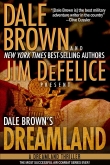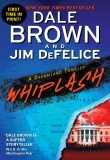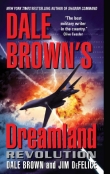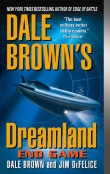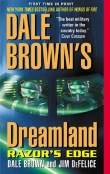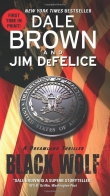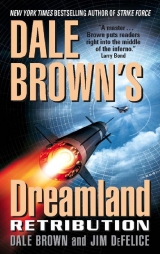
Текст книги "Retribution"
Автор книги: Dale Brown
Жанр:
Боевики
сообщить о нарушении
Текущая страница: 12 (всего у книги 23 страниц)
The fuse worked only on impact, which made the use of decoys less effective. On the other hand, it also meant that the weapon had to actually strike something to go off.
The Megafortress’s four turbojets were sexy targets for the missile’s seeker, red hot magnets that pulled it onward.
The Bennett’s altitude was its one advantage; while the airplane was almost directly over the man who had fired the missile, the aircraft had been at 10,000 feet, the very edge of the Stinger’s lethal envelope. Dog mashed the throttle, knowing he’d need every ounce of power to get away. As the decoys bloomed behind him, he twisted sharply, taking roughly five g’s and trying to cut as close to 180 degrees as possible.
The turn and flares made it hard for the Stinger to sniff its target, and by the time the Stinger realized it had to turn, it was too late. The rocket propellant in its slender chassis spent, the missile tumbled back to the ground.
“Starship, you see who fired at us?”
“Got a glimpse, Colonel.”
“They Chinese troops?”
“Negative. Look like guerrillas, some sort of irregulars.
Dressed, you know, kind of like natives, farmers or something.”
“Pretty clear they’re not farmers,” snapped Dog.
“Maybe they’re growing missiles,” said Sullivan.
The rest of the crew laughed—more to release tension than because the joke was funny. But it was a good sign, Dog thought; they were starting to get used to dealing with combat.
It wasn’t, however, a time to relax.
“Two Sukhoi-27s, early models, flying straight for us,”
said Rager, summarizing the situation for Dog. “Two hundred nautical miles from us. From the northeast. Chinese.
They’re subsonic, 500 knots, 23,000 feet. Behind them there RETRIBUTION
209
are two helicopters, 10,000 feet. Type ID’d as Harbin Z-5
Hound. Troop carriers.”
“Flighthawk leader, do you have the exact location of the warhead?” Dog asked Starship.
“Negative, Colonel. Looks like it’s in a lake. I haven’t confirmed it’s there.”
“Get on with Dreamland Command. See if the scientists can pin it down.”
“Roger that.”
The territory they were flying over was Indian but heavily populated by Muslims, and there were a variety of separatist groups active in the area. Some were suspected to be allied with Islamic terrorists, and even those that weren’t would find a ready market for a nuclear warhead. The question in Dog’s mind was what was China’s interest. Were they protecting their nearby border, or working with the people on the ground?
“Bennett to Danny Freah. Whiplash leader, what’s your status?”
Danny Freah’s tired face came onto the com screen. The camera in the smart helmet was located at the top of the visor, and the image had a fish-eye quality to it. It exaggerated the puffiness under his eyes, so the captain looked like he had two shiners.
“Freah. We’re about ready to bug out, Colonel.”
“We think we found the I-20 warhead. There are two problems. One, it may be underwater. Two, we have what look like local guerrillas on the ground, and the Chinese seem to be interested as well.”
Because of the location, it would take several hours for a fresh group of Marines to come in from the gulf. By then the guerrillas and/or the Chinese might have recovered the weapon.
Danny got hold of the Osprey pilots and discussed the situation. They could send one of their Ospreys with troops east; it would take roughly an hour and a half to reach the site. Reinforcements could include another bird, which would refuel them.
210
DALE BROWN’S DREAMLAND
Assuming Dreamland Command could pinpoint the warhead and that divers could then find it, the Osprey could be used to lift it from the water. There was another problem, however: Of the twenty Marines and the handful of Navy technical people Danny could bring, only Danny was qualified as a diver.
And the three Whiplashers who had been at the Pakistani house.
“Admiral Woods’s chief of staff wanted all three of our guys sent over to the Lincoln ASAP,” said Danny. “In the meantime, they were to stay on the sidelines if possible.”
“It’s not possible,” said Dog. “Take whoever you need with you. I’ll clear it with the admiral. Assuming our guys are OK.”
“I don’t know about Jonesy or Blow,” said Danny. “They were both shot. The gear protected them, but they’re pretty, uh, you know … mentally, with the kid—”
“What about Liu?”
“I think he’s OK.”
“All right. As long as he can carry out the mission. Use your best judgment.”
There was a time, before Dreamland, before he ever engaged in combat, that Dog would not have asked whether his subordinates could carry out a mission he knew they were physically capable of. But having been through combat, he’d learned how it could wear at you over time. More important, he’d also learned that a good percentage of people didn’t realize the toll it took, and that most of the others would ignore that toll because they felt their duty was to perform the mission. His job as a commander was to make the call for them, insisting that they sit down when sitting down was the best thing for them, and the best thing ultimately for the mission.
Were they at that point? Seeing a baby die, seeing a husband self-destruct up close—these were somehow different than deaths in combat, however horrific. Having people you were trying to save turn on you at a tragic moment—how much more terrible was that than killing a sniper at long distance?
RETRIBUTION
211
“Get over there, then, as fast as you can,” Dog told Danny.
Then he killed the transmission and called the Cheli to back him up. He’d talk to Admiral Woods—and General Samson—as soon as he had the situation under control.
Aboard Dreamland Cheli,
over northwest India
2320
THOUGH SHE HAD BEEN FINISHED ONLY A FEW WEEKS AFTER
the Bennett, the EB-52 Cheli incorporated a number of improvements both subtle and significant. Like her mate, the Megafortress had been rebuilt from an earlier incarnation, in this case a Model H that had once served with the Nineteenth Bomb Wing at Homestead Air Force Base in Florida. She was optimized for radar work and included the latest upgrades to both the airborne and ground search and surveillance radars, as well as software that allowed the bomber to target missiles launched by other sources. Like most Megafortresses, there were two Flighthawk bays, upper and lower.
Unlike the Bennett, the upper Flighthawk bay was operational; instead of bunks, there were two more Flighthawk control stations, allowing the aircraft to control a total of eight robots, though for now she was equipped only with two. The Cheli’s uprated engines allowed her to take off with a full load without tapping the engines of the four Flighthawks she could hold under her wings.
The aircraft’s ECM suite had been updated as well. While not as comprehensive as the ELINT, or electronic intelligence, versions of the Megafortress, which could listen to as well as jam a wide range of communications, the Cheli could suppress antiaircraft fire from ground and aircraft by scrambling radar and command signals the way the now retired Wild Weasels once had. Dreamland’s wizards had studied recent encounters with the Chinese and updated the electronics to do a better job against their weapons. They had also 212
DALE BROWN’S DREAMLAND
added transcripts of the air battles to the computers that helped fly the plane, providing the Tactics section with better information on what to expect from the planes they encountered.
Her pilot, Captain Brad Sparks, was in some ways also a new version of the breed. Sparks had been at Dreamland as a lieutenant three years before, working briefly on the Megafortress project, where, among other things, he had helped perform a feasibility study on using the aircraft as a tanker.
He’d transferred out just before Dog arrived, promoted to a captain and assigned to a B-1B squadron.
When Dreamland began getting involved in operational missions, Sparks realized he’d made a mistake and started angling for a comeback. He’d arrived two weeks before, and already he could tell it was the best decision he’d ever made in his life.
“Colonel Bastian for you,” said his copilot, Lieutenant Nelson Wong.
“Colonel, how goes it?” said Sparks, snapping his boss’s image on his com screen. The EB-52’s “dashboard” was infinitely configurable, but like most Megafortress pilots, Sparks kept the communications screen at the lower left, just below a screen that fed data and images from the Flighthawks.
“We’ve located another warhead, very far north,” Dog told him. “It’s in a lake. Looks like the Chinese are interested in it as well.”
“Hot shit.”
“Excuse me?”
“What do you need us to do, Colonel?”
“These are the coordinates of the site. The Bennett will go north and try and divert the Chinese. I’d like you to back us up and help provide cover for the ground unit; they should be there inside of ninety minutes. How soon can you get up here?”
“Thirty minutes,” said Sparks, though he knew he was being optimistic—the Cheli was nearly five hundred miles away.”
RETRIBUTION
213
“Be advised that the Chinese used long-range radiation-seeking missiles against us. They look like AA-10 Alamos but have at least twice the range. We took them down with Anacondas. We have two Su-27s approaching, and we’re unsure how they’re armed.”
“We’re on it, Colonel.”
“Alert me when you’re within ten minutes.” The screen went blank.
The cavalry to the rescue, thought Sparks before telling the rest of the crew what was going on. Getting back to Dreamland was the best thing he’d ever done.
Aboard Dreamland Bennett,
over Pakistan
2345
DOG’S GOAL WAS SIMPLE—KEEP THE HELICOPTERS FROM
landing at the site. They were well within range of his Anaconda antiair missiles, but he had only two left. If he used them against the helicopters, he’d have only the Flighthawks as his defense against the Su-27s.
A much better option was to engage the fighters first, get them out of the way, and then deal with the helicopters. After telling Starship what was up, Dog turned the Megafortress in the Sukhois’ direction.
Unlike the MiG-31s, the Sukhois hadn’t followed him through his course changes. There was no question in his mind that they were heading toward the warhead site and had to be considered hostile, but he wasn’t sure if they were carrying long-range weapons like the other planes. He decided he couldn’t take the chance. His only option was to take them out before they were close enough to use their weapons.
“Range on Bandits Three and Four, ” he said to Sullivan.
“Just coming up to 180 miles.”
“Stand by the Anacondas,” Dog told Sullivan.
“Standing by.”
214
DALE BROWN’S DREAMLAND
“Target them and fire.”
The missiles whisked away from the Megafortress. Dog held his course, watching the MiGs continue to approach, clearly unaware of their impending doom. Only at the last second did they realize their danger, jerking desperately to the east and west as the missiles bore in.
It was far too late. The Anacondas exploded only a few seconds apart, obliterating the Sukhois so completely that neither crew could eject.
“The helicopters are all yours,” Dog told Starship. Then he dialed into the fleet satellite communications channel to tell Woods what was going on.
THE HARBIN Z-5 HOUND WAS A CHINESE VERSION OF THE
Russian Mil Mi-4, a 1950s-era transport that typically carried fourteen troops and three crew members. Though the Chinese versions were improved somewhat, the basic design remained the same, a thick, two-deck fuselage beneath a massive rotor and a long, slim tail. The aircraft were pulling 113 knots, close to their top speed, flying twenty feet over the landscape.
They were easy prey for the Flighthawks. Starship kept the two U/MFs in a trail and took control of the first aircraft, flying a head-on attack against the lead helicopter. On his first pass he raked the cockpit and the engine compartment immediately behind it with 20mm cannon fire, decapitating the aircraft. There was no need for a second pass.
The other chopper tried to get away by twisting to the west, through a mountain pass. But the pilot miscalculated in the dark. By the time Starship turned Hawk One in its direction, the aircraft was burning on the side of the mountain, its rotors sheered off by a collision with the side wall of the canyon.
“Choppers are down,” Starship told Colonel Bastian. “I need to refuel.”
“Roger that,” said Dog.
RETRIBUTION
215
Dreamland Command
1100
TO SAMSON’S GREAT DISAPPOINTMENT, RAY RUBEO HAD
left Dreamland Command to supervise some tests in another part of the complex.
Samson didn’t intend to fire him—not yet, anyway. Given the administration’s interest in the missile recovery operation, there was no sense doing anything that might possibly derail it.
Or give critics something to focus on if the mission failed.
But he did want to put Rubeo in his place. And he would, he promised himself, as soon as possible.
“I’m not here to interfere,” Samson told Major Catsman.
“I want you all to proceed as you were. But let’s be clear on this—I am the commander of this base, and of this mission. The Whiplash order is issued in my name. Understood?”
“Yes, sir.”
Samson detected a note of dissension in Catsman’s voice, but let it slide. A bit of resistance in a command could be a good thing, as long as it was controllable.
“Update me on the process, please. Where specifically are our people? How many missiles have yet to be recovered?
All of the details. Then I want to speak with Colonel Bastian, and finally Admiral Woods.”
“There is a bit of a time difference between Dreamland and the area they’re operating in,” said Catsman.
“I’m sure Colonel Bastian won’t mind being woken to brief me.”
“It wasn’t him I was thinking of, sir. Colonel Bastian is already awake, and on a mission. Admiral Woods, on the other hand …”
Samson smiled. He had tangled with Woods several times while deputy commander of the Eighth Air Force, and owed him a tweaking or two.
“Tex Woods and I go way back,” Samson told Catsman.
216
DALE BROWN’S DREAMLAND
“Disturbing his sleep would be one of life’s little pleasures.”
Catsman gave him a tally of the warheads that had been recovered and a rundown on the overall situation; her briefing was, in fact, extremely thorough. And when she turned to tell a civilian at a console to make the connection to Bastian, the colonel came on almost instantaneously, his half-shaven face filling the main screen.
“General, I need to update you on a serious situation,” said the colonel from the cockpit of his Megafortress.
“Very good, Colonel. Fire away,” said Samson, noting the serious and, he thought, slightly subservient tone. Bastian was getting the message.
“We’ve engaged Chinese fighters,” Dog told him.
Samson felt his jaw lock as Colonel Bastian continued, explaining everything that had happened. The engagement surely was necessary—the alternative was to be shot down—but as Colonel Bastian freely admitted, it went against the standing orders not to engage the Chinese.
And then Bastian told him about the incident at the Pakistani farmhouse.
“Jesus, Bastian! What are your people trying to do?” bellowed the general. “Do you know how that’s going to look?
Can you imagine when the media gets hold of this? My God!”
Dog explained that they had video of the incident that would back them up. Samson felt as if a sinkhole had opened beneath his feet.
“Admiral Woods knows about the incident,” Dog added.
“He’s ordered our men back to Base Camp One. But I needed one to help check the lake where the warhead is.”
At least it’s not just my orders he disregards, Samson thought.
“That’s our situation,” said Dog. “Things are a little busy here, General. If you don’t mind I’m going to get back to work.”
“Yes,” said Samson, not sure what else to say.
“Admiral Woods for you, General,” said Catsman as the RETRIBUTION
217
screen changed back to a large-scale situation map. “He’s a little piqued at being woken. I told him you wanted to give him an important update.”
“I might as well talk to him now,” said Samson sarcastically. “While he’s in a good mood.”
Aboard Dreamland Bennett,
over Pakistan
2357
STARSHIP TOOK TWO QUICK PASSES OVER THE GROUP AT
the lake to get an idea of how many men were there and what other surprises they might have.
There were nine. He could see Kalashnikovs and one gre-nade launcher, but no more Stinger missiles. Two or three pack animals—from the air they looked like camels, though the pilot suspected they were donkeys—were tied together a short distance away.
Starship pushed the Flighthawk closer to the earth as he widened his orbit, trying to find supporting units that might be hiding in the jagged rocks nearby. There were no roads that he could see, and if there was a warm body in the neighborhood, the infrared scan couldn’t find it.
The mountains were as desolate as anyplace on earth, emptier even than the desert where most of the warheads had landed. The nearest village looked to be a collection of hovels pushed against a ravine about five miles to the east.
A road twisted about a mile below the settlement; Starship spotted two paths connecting them but found no one on them.
“Should I take these guys out, Colonel, or what?”
“Let’s wait until the Osprey is a little closer,” Dog told him. “They may pull the warhead from the lake and save us some work.”
“Roger that.”
* * *
218
DALE BROWN’S DREAMLAND
DOG DECIDED IT WAS PRUDENT TO KEEP THE BENNETT WELL
above the ground, establishing an orbit around the area at 40,000 feet, high enough that the black Megafortress could neither be seen nor heard from the ground. With the Osprey still about an hour away, he had the two radar operators take short breaks, sending Sullivan back to monitor their equipment while they got some coffee and relaxed for a few minutes. It wasn’t much of a break, but it relieved the monotony a bit and let them know he was thinking of them. They were warming to him slightly, but he still wouldn’t have gotten many votes for commander of the month.
The Dreamland Command channel buzzed with an in-coming message from General Samson.
“Colonel Bastian, good morning again.”
“It’s just about midnight here, General.”
“Woods is not particularly pleased, but I think he’ll accept the fact that you had no choice but to shoot down the Chinese. What the hell are they up to?”
“I’m not sure. I haven’t spoken to Jed Barclay about it. He may have an opinion.”
“Jed Barclay?”
Dog explained who Jed Barclay was and how he liaisoned with the different agencies involved in operations.
“Well, I’ll see what he knows,” said Samson.
“There’s one other thing,” said Dog, sensing that Samson was about to sign off.
“Well?”
“We still have two crewmen missing. The Navy has been doing the search but—”
“Where are they missing?”
“The mid-Indian coast. I’d like to supplement that. I’d like to dedicate one of our radar surveillance planes full-time to the mission.”
“Recovering the warheads takes precedence. The President wants that done. That’s where your efforts have to be concentrated.”
“They’re our people, sir. No offense meant to the Navy.”
RETRIBUTION
219
Samson frowned. “I’ll talk to Woods. We’ll get a better effort out of them.”
“I don’t mean that they’re doing a bad job,” said Dog. “Just that we can help them do a better one.”
“I told you I’ll take care of it,” said Samson. “Keep me updated.”
The screen blanked.
“Nice to talk to you too,” said Dog.
Aboard Marine Osprey Angry Bear One, over western Pakistan
0130, 18 January 1998
JENNIFER GLEASON BALANCED THE LAPTOP BETWEEN HER
legs, squinting at the close-set type as she continued her doc-torate-level briefing in rocket science.
Or more specifically, rocket-guidance electronics, and how they interacted with T waves.
While the T-Rays had fried most of the missile’s circuitry, one of the solenoid valves and two electronic level sensors—parts used in the rocket motor itself—had apparently escaped damage. The experts at Dreamland theorized that something had inadvertently shielded these pieces. Jennifer hadn’t spotted any sign of deliberate shielding, she could not see a difference between the unaffected solenoid valve and another unit that had failed.
The first reaction at Dreamland was that she must have missed something, and they forwarded her reams of technical data. Having now read six different papers explaining how the systems worked, she had enough background to be as confused as the experts.
One of the T-Ray experts believed that whatever had shielded the parts simply vaporized during the crash. This seemed plausible, especially if what shielded the components had actually been part of something else, such as a temperature monitor for one of the fuel tanks. The shields used by 220
DALE BROWN’S DREAMLAND
the Megafortresses were not thick pieces of lead or other heavy metal, but a thin mesh of wires that ran current when the T-Rays hit. The shields were “tuned” to catch the radiation in the way a sound-canceling machine “caught” or neutralized sound; the shield’s trough effectively neutralized the T-Ray’s mountain peak. A thin-wire temperature sensor, or perhaps a radio antenna, might have accidentally provided a partial shield.
Jennifer thought it more likely that there wasn’t enough information about how the T-Rays worked, and that they were interacting with something else. If this were the case, it could take years before the problem was actually solved. In any event, she had to gather as much data as possible.
The Osprey jerked as it hit a bit of turbulence, and the Marine sitting next to her brushed against her. Jennifer shot him a glance. His eyes were fixed on the mesh deck between his combat boots. He looked young, nineteen or twenty at most, and very tired.
None of the men aboard the aircraft—she was the only woman—had slept much in the last forty-eight or seventy-two hours. Even Captain Freah, who ordinarily never looked tired, seemed beat.
She knew there was a good chance she looked as tired as they did. She brushed back a strand of hair from her ear, then turned her attention back to the laptop, bringing up another technical paper to read.
Sergeant Liu glanced around the cabin, nervous for the first time in as long as he could remember.
The sergeant didn’t consider himself a particularly brave man. On the contrary, he thought of himself as prudent and careful, not much of a risk taker. While others might view his job as exceedingly risky, in Liu’s view, working special operations was a good deal less hazardous than most combat jobs in the service. He continually trained and practiced, and worked with only the most qualified people. Missions were generally carefully planned and laid out. As long as you re-
RETRIBUTION
221
membered your training and did your job, the odds were in your favor. There was no reason to be scared.
But he was nervous tonight, very nervous.
The image of the little kid being born stayed in his head.
Possibly—probably—the child was dead before he was born, but he had no way of knowing.
Why had God sent them to the house if He intended on letting the child and its parents die?
A Catholic Chinese-American, Liu had always felt some solace in his faith, but now it seemed to raise only questions.
He knew what a priest would tell him: God has a plan, and we cannot always know it. But that didn’t make sense in this case—what plan could He accomplish by letting a child die?
Why go to such extraordinary lengths to send help to the baby, then snuff its life out? And the lives of its parents?
Liu looked up. Captain Freah was staring at him.
“You ready, Nurse?” Danny asked.
“Ready and willing,” said Liu, shrugging.
Aboard Dreamland Bennett,
over Pakistan
0201
WHEN THE OSPREY WAS TEN MINUTES FROM THE LANDING
zone, Dog gave Starship the order to take out the guerrillas on the ground.
Starship had the two Flighthawks moving in figure eight orbit over the lake. He took them over from the computer and brought them down so they could make their attacks from opposite sides, catching the men on the ground in the middle.
With a split screen and left and right joysticks, he felt briefly as if he were two people, each a mirror image of the other.
Green sparkles flashed on the screen of Hawk Two—tracers, fired by someone on the ground unit reacting to the sounds of the airplane.
The targeting box on the screen for Hawk One began to 222
DALE BROWN’S DREAMLAND
blink, indicating that the computer thought he was almost close enough to shoot. Starship held off for another few seconds, then opened fire just as the tracers turned in his direction.
The effect was brutal and efficient, lead pouring into the men who’d tried to shoot him down little more than an hour earlier. Only two of the men on the ground seemed to escape the first pass, running to the north and throwing themselves on the ground as the Flighthawks passed east and west.
Starship cleared both of the robot planes upward, circled them around, and then pushed into a new attack, this one with the two aircraft in a staggered trail, so that Hawk Two flew a bit behind and to the right of Hawk One.
